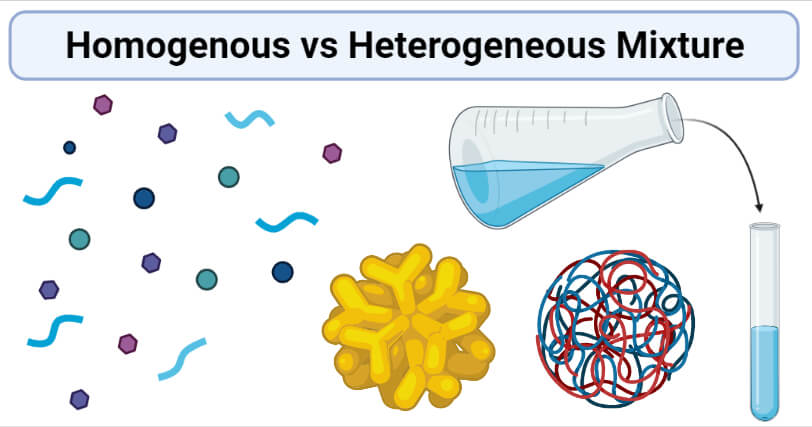Homogenous Mixture Definition
A homogenous mixture is the type of mixture in which the composition of the solute is uniform throughout the mixture.
- The homogenous mixture can be defined by the fact that the division of the mixture into two equal halves results in the distribution of the same amount of solute suspended in both of the halves.
- In a homogenous mixture, the individual elements of the mixture cannot be distinguished with the naked eyes. Only a single phase of matter is visible in a homogeneous mixture.
- Along with the composition, the physical and chemical properties of each part of the mixture are also the same.
- The separation of the components of a homogenous mixture is not possible by simple mechanical means like filtration and sieving. Instead, complex means are to be applied depending on the nature of the components.
- The size of the particles present in a mixture usually is in the range of atomic or molecular size.
- Homogenous mixtures are also called solutions, as the components of the mixture cannot be distinguished.

Heterogeneous Mixture Definition
A heterogeneous mixture is the type of mixture in which the composition of the solute is not uniform throughout the mixture.
- Thus, in a heterogeneous mixture, all parts of the mixture do not have the same concentration throughout.
- The components of a heterogeneous mixture are easily visible in the mixture as the size of the particles tends to be larger.
- Different components of a mixture might also exist in different phases, which enable the separation of the particles by simple mechanical means.
- The physical and chemical properties of the mixture might be different in different parts as these depend on the concentration of the solute, which, in turn, is not uniform throughout.
- Depending on the type of mixture and the components present in it, the particles might either remain mixed or just lie on top of each other.
- If the particles are heavier or larger in size, these might even settle down to form distinct groups.
- Heterogeneous mixtures are either colloids or suspensions, depending on the size of the dispersed particles.
Read Also: Compound vs Mixture- Definition, 12 Major Differences, Examples
8 Major Differences (Homogenous vs Heterogeneous Mixture)
| Characteristics | Homogenous Mixture | Heterogeneous Mixture |
| Definition | A homogenous mixture is the type of mixture in which the composition of the solute is uniform throughout the mixture. | The heterogeneous mixture is the type of mixture in which the composition of the solute is not uniform throughout the mixture. |
| Particle size | The size of the particles dispersed in the mixture usually lies within the range of atomic and molecular size. | The size of the particles dispersed in a heterogeneous mixture is larger. |
| The particles are not visible with the naked eyes. | The particles are mostly visible with the naked eyes. | |
| Differentiation | The components of a homogenous mixture cannot be distinguished within the mixture. | The components of a heterogeneous mixture can be distinguished as separate components. |
| Separation | The components of a homogenous mixture cannot be separated by simple physical means like filtration and sieving. | The components of a heterogeneous mixture can be separated by simple physical means like filtration. |
| Phases | All the components of a homogenous mixture exist in a single phase. | The components of a heterogeneous mixture exist in different phases. |
| Properties | All parts of the mixture have the same physical and chemical properties. | Different parts of the mixture might have different physical and chemical properties. |
| Examples | Solutions are examples of the homogenous mixture. | Colloids and suspensions are examples of a heterogeneous mixture. |
Examples of a homogenous mixture
Solution
- The solution is a type of homogenous mixture composed of solute and solvent where the solute is completely dissolved in the solvent.
- Solutions usually exist in the state of the solvent as it is the larger fraction of the mixture in most cases.
- The solution is defined by concentration which is the measure of the amount of solute in a defined amount of solvent or the solution.
- Since the solution is a homogenous mixture, the solute particles are completely dissolved and thus, cannot be seen with the naked eyes.
- It exists in a single phase, which is usually that of the solvent. The components, i.e., solute and solvent, cannot be removed by mechanical means like filtration.
Examples of a heterogeneous mixture
Colloid
- A colloid is an example of a heterogeneous mixture where the components exist in two distinct phases; dispersed phase and continuous phase.
- The insoluble particles of a colloid do not settle down completely as the particles are small in size, usually ranging between 10-7 to 10-3 cm.
- Colloids tend to have a slight color as they exhibit the Tyndall effect as a result of the dispersion of light.
- The colloidal matter might be separated by physio-chemical means like aggregation as the particles tend to clump together to form larger particles.
- The stability of a colloid depends on the measure of particles that are suspended in the mixture at equilibrium.
References and Sources
- https://www.differencebetween.com/difference-between-mixture-and-vs-solution/- 9%
- https://www.thoughtco.com/heterogeneous-and-homogeneous-mixtures-606106- 8%
- https://studiousguy.com/homogeneous-mixture-examples/- 6%
- https://tutors.com/lesson/homogeneous-mixture- 6%
- https://chem.libretexts.org/Courses/University_of_Kentucky/UK%3A_CHE_103_-_Chemistry_for_Allied_Health_(Soult)/Chapters/Chapter_7%3A_Solids%2C_Liquids%2C_and_Gases/7.6%3A_Colloids_and_Suspensions- 3%
- https://www.biomadam.com/difference-between-homogeneous-heterogeneous-mixtures- 1%
